
The Solomon R. Guggenheim Museum, often referred to as The Guggenheim, is an art museum at 1071 Fifth Avenue between 88th and 89th Streets on the Upper East Side of Manhattan in New York City. It hosts a permanent collection of Impressionist, Post-Impressionist, early Modern, and contemporary art and also features special exhibitions throughout the year. It was established by the Solomon R. Guggenheim Foundation in 1939 as the Museum of Non-Objective Painting, under the guidance of its first director, Hilla von Rebay. The museum adopted its current name in 1952, three years after the death of its founder Solomon R. Guggenheim. It continues to be operated and owned by the Solomon R. Guggenheim Foundation.

Gracie Mansion is the official residence of the mayor of New York City. Built in 1799, it is located in Carl Schurz Park, at East End Avenue and 88th Street in the Yorkville neighborhood of Manhattan. The Federal-style mansion overlooks Hell Gate channel in the East River and consists of two sections: the original two-story house and an annex built in 1966. The original house is a New York City designated landmark and is listed on the National Register of Historic Places.

The Jewish Museum is an art museum and repository of cultural artifacts, housed at 1109 Fifth Avenue, in the former Felix M. Warburg House, along the Museum Mile on the Upper East Side of Manhattan, New York City. The first Jewish museum in the United States, as well as the oldest existing Jewish museum in the world, it contains the largest collection of art and Jewish culture excluding Israeli museums, more than 30,000 objects. While its collection was established in 1904 at the Jewish Theological Seminary of America, the museum did not open to the public until 1947 when Felix Warburg's widow sold the property to the Seminary. It focuses both on artifacts of Jewish history and on modern and contemporary art. The museum's collection exhibition, Scenes from the Collection, is supplemented by multiple temporary exhibitions each year.

The Morgan Library & Museum is a museum and research library at 225 Madison Avenue in the Murray Hill neighborhood of Manhattan in New York City, U.S. Completed in 1906 as the private library of the banker J. P. Morgan, the institution has more than 350,000 objects. As of 2024, the museum is directed by Colin B. Bailey and governed by a board of trustees.
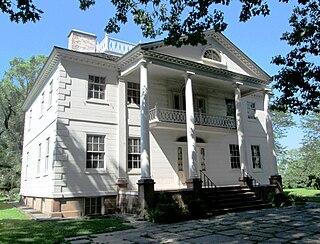
The Morris–Jumel Mansion is an 18th-century historic house museum in the Washington Heights neighborhood of Upper Manhattan in New York City. It is the oldest extant house in Manhattan, having been built in 1765 by British military officer Roger Morris, and was also home to the family of socialite Eliza Jumel in the 19th century. The New York City government has owned the house since 1903. The house's facade and interior are New York City designated landmarks, and the building is a National Historic Landmark and a contributing property to the Jumel Terrace Historic District.

The Gertrude Rhinelander Waldo House is a French Renaissance Revival mansion at the southeastern corner of Madison Avenue and 72nd Street on the Upper East Side of Manhattan in New York City. Built between 1894 and 1898, it was designed by Alexander Mackintosh of the architectural firm of Kimball & Thompson. The house was commissioned by the heiress Gertrude Rhinelander Waldo, who never moved in. It was converted to a commercial building in the 20th century, becoming the New York City flagship store of the Ralph Lauren accessory and clothing company in the 1980s. The mansion is a New York City designated landmark and on the National Register of Historic Places.

The Otto H. Kahn House is a mansion at 1 East 91st Street, at Fifth Avenue, in the Carnegie Hill section of the Upper East Side of Manhattan in New York City. The four-story mansion was designed by architects J. Armstrong Stenhouse and C. P. H. Gilbert in the neo-Italian Renaissance style. It was completed in 1918 as the town residence of the German-born financier and philanthropist Otto H. Kahn and his family. The Convent of the Sacred Heart, a private school, owns the Kahn House along with the adjacent James A. Burden House, which is internally connected. The mansion is a New York City designated landmark and, along with the Burden House, is listed on the National Register of Historic Places.

Felix Moritz Warburg was a German-born American banker. He was a member of the Warburg banking family of Hamburg, Germany.

The St. Regis New York is a historic luxury hotel at 2 East 55th Street, at the southeast corner with Fifth Avenue, in the Midtown Manhattan neighborhood of New York City. The hotel was originally developed by John Jacob Astor IV and was completed in 1904 to designs by Trowbridge & Livingston. An annex to the east was designed by Sloan & Robertson and completed in 1927. The hotel is operated by Marriott International and holds Forbes five-star and AAA five-diamond ratings. In addition, it is a New York City designated landmark.

The Daily News Building, also known as The News Building, is a skyscraper at 220 East 42nd Street in the Turtle Bay neighborhood of Midtown Manhattan in New York City. The original building was designed by architects Raymond Hood and John Mead Howells in the Art Deco style, and was erected between 1928 and 1930. A later addition was designed by Harrison & Abramovitz and built between 1957 and 1960.
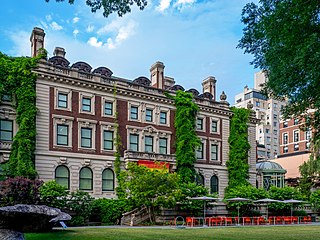
The Andrew Carnegie Mansion is a historic house and a museum building at 2 East 91st Street, along the east side of Fifth Avenue, on the Upper East Side of Manhattan in New York City. The three-and-a-half story, brick and stone mansion was designed by Babb, Cook & Willard in the Georgian Revival style. Completed in 1902 for the industrialist Andrew Carnegie, his wife Louise, and their only child Margaret, it served as the family's residence until 1946. Since 1976, the house has been occupied by the Cooper-Hewitt Museum, part of the Smithsonian Institution. The mansion is internally connected to two townhouses at 9 East 90th Street and 11 East 90th Street, both of which are part of the Cooper-Hewitt.
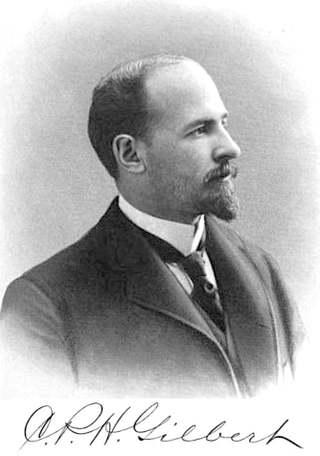
Charles Pierrepont Henry Gilbert was an American architect of the late-19th and early-20th centuries best known for designing townhouses and mansions.

The James B. Duke House is a mansion at 1 East 78th Street, on the northeast corner of Fifth Avenue, on the Upper East Side of Manhattan in New York City. The building was designed by Horace Trumbauer, who drew heavily upon the design of Château Labottière in Bordeaux. Constructed between 1909 and 1912 as a private residence for businessman James Buchanan Duke and his family, the building has housed the New York University (NYU)'s Institute of Fine Arts since 1959.

The Appellate Division Courthouse of New York State, First Department, is a courthouse at the northeast corner of Madison Avenue and 25th Street in the Flatiron District neighborhood of Manhattan in New York City, United States. The courthouse is used by the First Department of the New York Supreme Court's Appellate Division. The original three-story building on 25th Street and Madison Avenue, designed by James Brown Lord, was finished in 1899. A six-story annex to the north, on Madison Avenue, was designed by Rogers & Butler and completed in 1955.

The James A. Burden House is a mansion at 7 East 91st Street in the Carnegie Hill section of the Upper East Side of Manhattan in New York City. The five-story mansion was designed by architects Warren and Wetmore in the Beaux-Arts style. It was completed in 1905 as the residence of iron entrepreneur James A. Burden Jr. and his wife Florence Sloane Burden. The Convent of the Sacred Heart, a private school, owns the Burden House along with the adjacent Otto H. Kahn House, which is internally connected. The mansion is a New York City designated landmark and, along with the Kahn House, is listed on the National Register of Historic Places.
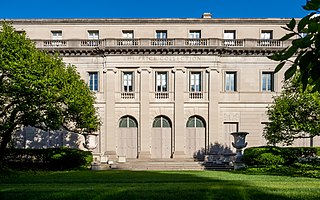
The Henry Clay Frick House is a mansion and museum building on Fifth Avenue, between 70th and 71st streets, on the Upper East Side of Manhattan in New York City. Designed by Thomas Hastings as the residence of the industrialist Henry Clay Frick, the house contains the Frick Collection museum and the Frick Art Reference Library. The house and library building are designated as a New York City landmark and National Historic Landmark.
Edward Mortimer Morris Warburg was an American philanthropist and patron of the arts from New York City. He taught Modern Art at Bryn Mawr College and he was vice director for public affairs of the Metropolitan Museum of Art. He was a co-founder of the American Ballet and the School of American Ballet. He collected many paintings and sculptures, and donated the bulk of them to museums, especially the Museum of Modern Art.

Frieda Warburg was a Jewish-American philanthropist and communal worker from New York.
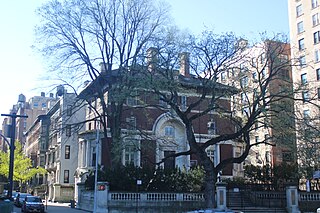
The Isaac L. Rice Mansion is a mansion at 346 West 89th Street and Riverside Drive on the Upper West Side of Manhattan in New York City. It was designed by Herts & Tallant and built between 1901 and 1903 for the family of the businessman Isaac Rice and his wife Julia. Several further expansions in the 20th century, designed by C. P. H. Gilbert, Bloch & Hesse, and William Lazinsk, are similar in style to the original building. The Rice Mansion has served as a yeshiva, or Jewish school, since 1954 and is one of only two free-standing mansions extant on Riverside Drive. The house is a New York City designated landmark and is listed on the National Register of Historic Places.






















